#SRAM programming
Explore tagged Tumblr posts
Text
SRAM chip, SRAM programming, non volatile static ram, SRAM manufacturers
AS6C62256 Series 256-kbit (32 K x 8) 3.3 V 55 ns CMOS Static RAM - PDIP-28
0 notes
Text
https://www.futureelectronics.com/p/semiconductors--memory--RAM--nvram--quantum-trap-nvsram/m95m02-drmn6tp-stmicroelectronics-8011669
Static ram manufacturers, Battery backed Static RAM, SRAM memory card
M95M02 Series 2 Mb (256 K x 8) 5.5 V Serial SPI Bus EEPROM - SOIC-8
#STMicroelectronics#M95M02-DRMN6TP#RAM#NVRAM#Nonvolatile SRAM (NVSRAM)#Static ram manufacturers#Battery backed Static RAM#SRAM memory card#SRAM programming#Memory ICs#SRAM manufacturers#Random Access Memory#SRAM memory chips#SRAM chip
1 note
·
View note
Text
https://www.futureelectronics.com/p/semiconductors--memory--RAM--nvram--quantum-trap-nvsram/m95m02-drmn6tp-stmicroelectronics-7140290
SRAM chip, SRAM memory card, SRAM memory chips, static random access memory
M95M02 Series 2 Mb (256 K x 8) 5.5 V Serial SPI Bus EEPROM - SOIC-8
#RAM#NVRAM#Nonvolatile SRAM (NVSRAM)#M95M02-DRMN6TP#STMicroelectronics#Ram digital#what is SRAM#non volatile SRAM#static RAM#SRAM chip#card#static random-access memory#RAM digital to analog converter#SRAM programming
1 note
·
View note
Text
https://www.futureelectronics.com/p/semiconductors--memory--RAM--static-ram--asynchronous/cy62157ev18ll-55bvxi-infineon-3728565
SRAM memory cell, Types of SRAM, data Memory, memory card reader
CY62157EV18 Series 8 Mb (512 K x 16) 1.65 - 2.25 V 55 ns Static RAM - VFBGA-48
#RAM#Static RAM#Asynchronous SRAM#CY62157EV18LL-55BVXI#Infineon#memory cell#Types of SRAM#data#card reader#programming#Random Access Memory#SRAM chip#flash memory card reader#Nv SRAM#SRAM memory#CMOS Static RAM
1 note
·
View note
Text
https://www.futureelectronics.com/p/semiconductors--memory--RAM--static-ram--asynchronous/cy62167ev30ll-45bvxi-infineon-6042923
Non-Volatile SRAM memory, Non-Volatile SRAM, Non volatile memory
CY62167EV30 Series 16 Mb (1M x 16/2M x 8) 2.2 - 3.6 V 45 ns Static RAM -TSOP-48
#RAM#Static RAM#Asynchronous SRAM#CY62167EV30LL-45ZXIT#Infineon#Non-Volatile SRAM memory#Non-Volatile SRAM#Surface Mount Flash Memory#Memory chips#Random-Access Memory#Volatile Memory#Programming System Devices
1 note
·
View note
Text
https://www.futureelectronics.com/p/semiconductors--memory--RAM--static-ram--asynchronous/cy62167ev30ll-45bvxit-infineon-1068579
Non Volatile SRAM memory, What is SRAM, SRAM manufacturers, SRAM chip
CY62167EV30 Series 16 Mb (1M x 16 / 2 M x 8) 3 V 45 ns Static RAM - FBGA-48
#RAM#Static RAM Asynchronous#SRAM#CY62167EV30LL-45BVXIT#Infineon#Non Volatile SRAM memory#What is SRAM#manufacturers#SRAM ram chip#Static random access memory#SRAM memories#Memory Density#Programming System Devices
1 note
·
View note
Text
https://www.futureelectronics.com/p/semiconductors--memory--RAM--nvram--quantum-trap-nvsram/m95m02-drmn6tp-stmicroelectronics-3034532
Non-volatile memory, SRAM data, SRAM chip programming, Non volatile memory
M95M02 Series 2 Mb (256 K x 8) 5.5 V Serial SPI Bus EEPROM - SOIC-8
#RAM#NVRAM#Nonvolatile SRAM (NVSRAM)#M95M02-DRMN6TP#STMicroelectronics#memory#data#SRAM chip programming#card#Random Access Memory#flip-flop circuit#SRAM application#what is SRAM#SRAM application system#chips#SRAM
1 note
·
View note
Text
https://www.futureelectronics.com/p/semiconductors--memory--RAM--nvram--quantum-trap-nvsram/m95m02-drmn6tp-stmicroelectronics-3034532
EPROM, FIFO's, Flash Memory, what is SRAM, Static RAM, SRAM transmission
M95M02 Series 2 Mb (256 K x 8) 5.5 V Serial SPI Bus EEPROM - SOIC-8
#RAM#NVRAM#Nonvolatile SRAM (NVSRAM)#M95M02-DRMN6TP#STMicroelectronics#Dual port memory#what is a dual port SRAM#Battery Backed SRAM#Dual Port Memory#EPROM#FIFO's#Flash Memory#Static RAM#transmission#Battery backed Static RAM#chip programming
1 note
·
View note
Text
Memory ICs, SRAM memory chips, SRAM chip programming, SRAM interface
CY62157E Series 8 Mb (512 K x 16) 4.5 - 5.5 V 45 ns Static RAM - TSOP-44
0 notes
Text
https://www.futureelectronics.com/p/semiconductors--memory--RAM--nvram--quantum-trap-nvsram/mx29f040cqi-70g-macronix-6159320
Static random access memory, types of volatile memory, sram programming
MX29F Series 4-Mbit (512 K x 8) 70 ns 5 V Surface Mount Flash Memory - PLCC-32
#Macronix#MX29F040CQI-70G#RAM#NVRAM#Nonvolatile#SRAM (NVSRAM)#SRAM solutions#sram memory#Ram digital#card#static random access memory#types of volatile memory#sram chip programming#Static RAM (SRAM)#sram memory chips
1 note
·
View note
Note
What are some of the coolest computer chips ever, in your opinion?
Hmm. There are a lot of chips, and a lot of different things you could call a Computer Chip. Here's a few that come to mind as "interesting" or "important", or, if I can figure out what that means, "cool".
If your favourite chip is not on here honestly it probably deserves to be and I either forgot or I classified it more under "general IC's" instead of "computer chips" (e.g. 555, LM, 4000, 7000 series chips, those last three each capable of filling a book on their own). The 6502 is not here because I do not know much about the 6502, I was neither an Apple nor a BBC Micro type of kid. I am also not 70 years old so as much as I love the DEC Alphas, I have never so much as breathed on one.
Disclaimer for writing this mostly out of my head and/or ass at one in the morning, do not use any of this as a source in an argument without checking.
Intel 3101
So I mean, obvious shout, the Intel 3101, a 64-bit chip from 1969, and Intel's first ever product. You may look at that, and go, "wow, 64-bit computing in 1969? That's really early" and I will laugh heartily and say no, that's not 64-bit computing, that is 64 bits of SRAM memory.
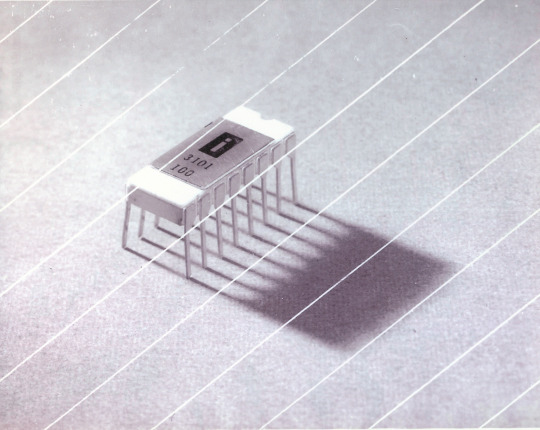

This one is cool because it's cute. Look at that. This thing was completely hand-designed by engineers drawing the shapes of transistor gates on sheets of overhead transparency and exposing pieces of crudely spun silicon to light in a """"cleanroom"""" that would cause most modern fab equipment to swoon like a delicate Victorian lady. Semiconductor manufacturing was maturing at this point but a fab still had more in common with a darkroom for film development than with the mega expensive building sized machines we use today.
As that link above notes, these things were really rough and tumble, and designs were being updated on the scale of weeks as Intel learned, well, how to make chips at an industrial scale. They weren't the first company to do this, in the 60's you could run a chip fab out of a sufficiently well sealed garage, but they were busy building the background that would lead to the next sixty years.
Lisp Chips
This is a family of utterly bullshit prototype processors that failed to be born in the whirlwind days of AI research in the 70's and 80's.
Lisps, a very old but exceedingly clever family of functional programming languages, were the language of choice for AI research at the time. Lisp compilers and interpreters had all sorts of tricks for compiling Lisp down to instructions, and also the hardware was frequently being built by the AI researchers themselves with explicit aims to run Lisp better.
The illogical conclusion of this was attempts to implement Lisp right in silicon, no translation layer.
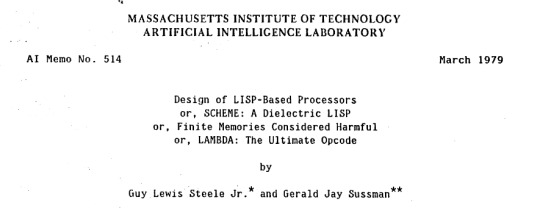
Yeah, that is Sussman himself on this paper.
These never left labs, there have since been dozens of abortive attempts to make Lisp Chips happen because the idea is so extremely attractive to a certain kind of programmer, the most recent big one being a pile of weird designd aimed to run OpenGenera. I bet you there are no less than four members of r/lisp who have bought an Icestick FPGA in the past year with the explicit goal of writing their own Lisp Chip. It will fail, because this is a terrible idea, but damn if it isn't cool.
There were many more chips that bridged this gap, stuff designed by or for Symbolics (like the Ivory series of chips or the 3600) to go into their Lisp machines that exploited the up and coming fields of microcode optimization to improve Lisp performance, but sadly there are no known working true Lisp Chips in the wild.
Zilog Z80
Perhaps the most important chip that ever just kinda hung out. The Z80 was almost, almost the basis of The Future. The Z80 is bizzare. It is a software compatible clone of the Intel 8080, which is to say that it has the same instructions implemented in a completely different way.
This is, a strange choice, but it was the right one somehow because through the 80's and 90's practically every single piece of technology made in Japan contained at least one, maybe two Z80's even if there was no readily apparent reason why it should have one (or two). I will defer to Cathode Ray Dude here: What follows is a joke, but only barely

The Z80 is the basis of the MSX, the IBM PC of Japan, which was produced through a system of hardware and software licensing to third party manufacturers by Microsoft of Japan which was exactly as confusing as it sounds. The result is that the Z80, originally intended for embedded applications, ended up forming the basis of an entire alternate branch of the PC family tree.
It is important to note that the Z80 is boring. It is a normal-ass chip but it just so happens that it ended up being the focal point of like a dozen different industries all looking for a cheap, easy to program chip they could shove into Appliances.
Effectively everything that happened to the Intel 8080 happened to the Z80 and then some. Black market clones, reverse engineered Soviet compatibles, licensed second party manufacturers, hundreds of semi-compatible bastard half-sisters made by anyone with a fab, used in everything from toys to industrial machinery, still persisting to this day as an embedded processor that is probably powering something near you quietly and without much fuss. If you have one of those old TI-86 calculators, that's a Z80. Oh also a horrible hybrid Z80/8080 from Sharp powered the original Game Boy.
I was going to try and find a picture of a Z80 by just searching for it and look at this mess! There's so many of these things.
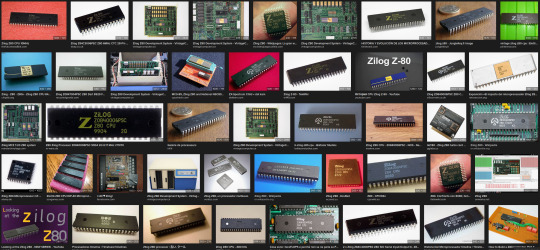
I mean the C/PM computers. The ZX Spectrum, I almost forgot that one! I can keep making this list go! So many bits of the Tech Explosion of the 80's and 90's are powered by the Z80. I was not joking when I said that you sometimes found more than one Z80 in a single computer because you might use one Z80 to run the computer and another Z80 to run a specialty peripheral like a video toaster or music synthesizer. Everyone imaginable has had their hand on the Z80 ball at some point in time or another. Z80 based devices probably launched several dozen hardware companies that persist to this day and I have no idea which ones because there were so goddamn many.
The Z80 eventually got super efficient due to process shrinks so it turns up in weird laptops and handhelds! Zilog and the Z80 persist to this day like some kind of crocodile beast, you can go to RS components and buy a brand new piece of Z80 silicon clocked at 20MHz. There's probably a couple in a car somewhere near you.
Pentium (P6 microarchitecture)
Yeah I am going to bring up the Hackers chip. The Pentium P6 series is currently remembered for being the chip that Acidburn geeks out over in Hackers (1995) instead of making out with her boyfriend, but it is actually noteworthy IMO for being one of the first mainstream chips to start pulling serious tricks on the system running it.

The P6 microarchitecture comes out swinging with like four or five tricks to get around the numerous problems with x86 and deploys them all at once. It has superscalar pipelining, it has a RISC microcode, it has branch prediction, it has a bunch of zany mathematical optimizations, none of these are new per se but this is the first time you're really seeing them all at once on a chip that was going into PC's.
Without these improvements it's possible Intel would have been beaten out by one of its competitors, maybe Power or SPARC or whatever you call the thing that runs on the Motorola 68k. Hell even MIPS could have beaten the ageing cancerous mistake that was x86. But by discovering the power of lying to the computer, Intel managed to speed up x86 by implementing it in a sensible instruction set in the background, allowing them to do all the same clever pipelining and optimization that was happening with RISC without having to give up their stranglehold on the desktop market. Without the P5 we live in a very, very different world from a computer hardware perspective.
From this falls many of the bizzare microcode execution bugs that plague modern computers, because when you're doing your optimization on the fly in chip with a second, smaller unix hidden inside your processor eventually you're not going to be cryptographically secure.
RISC is very clearly better for, most things. You can find papers stating this as far back as the 70's, when they start doing pipelining for the first time and are like "you know pipelining is a lot easier if you have a few small instructions instead of ten thousand massive ones.
x86 only persists to this day because Intel cemented their lead and they happened to use x86. True RISC cuts out the middleman of hyperoptimizing microcode on the chip, but if you can't do that because you've girlbossed too close to the sun as Intel had in the late 80's you have to do something.
The Future
This gets us to like the year 2000. I have more chips I find interesting or cool, although from here it's mostly microcontrollers in part because from here it gets pretty monotonous because Intel basically wins for a while. I might pick that up later. Also if this post gets any longer it'll be annoying to scroll past. Here is a sample from a post I have in my drafts since May:

I have some notes on the weirdo PowerPC stuff that shows up here it's mostly interesting because of where it goes, not what it is. A lot of it ends up in games consoles. Some of it goes into mainframes. There is some of it in space. Really got around, PowerPC did.
236 notes
·
View notes
Text
Let's take a moment to remember my imperfect, but ever useful portable XP powerhouse, the Toshiba Satellite P25-S507. Probably my favorite laptop of all time. It's old, but hardly vintage yet. I was given one as a hand-me-down after it grenaded its own RAM a year after it was purchased.
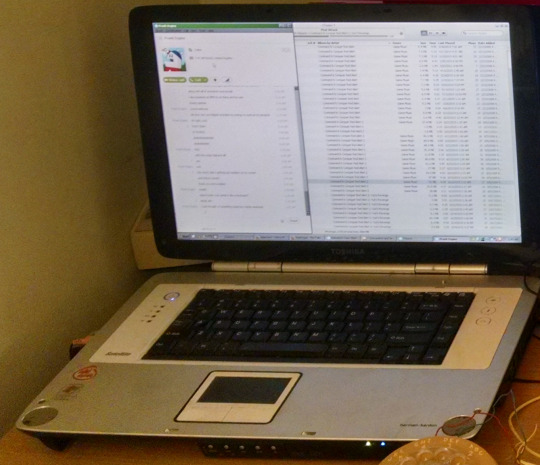
I used it as my music jukebox, played a ton of Command & Conquer games on it, did my high school and college school work, talked with my friends on AIM, Skype Teamspeak and IRC, edited videos, programmed on it, did image editing in photoshop.
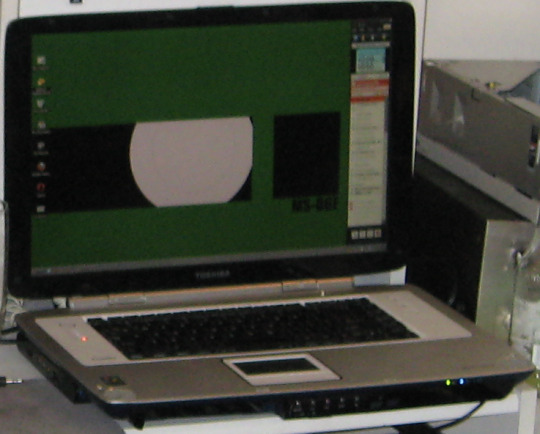
Pentium 4 @ 2.8GHz, 512MB DDR SRAM stock (mine was upgraded to 1GB and later 2GB), ~60GB hard drive, 17" WXGA TFT LCD, Windows XP (Home, but we upgraded it to Pro), ethernet jack AND wifi, DVD burner, SD card slot, all coming in at just shy of 10lbs of computer.
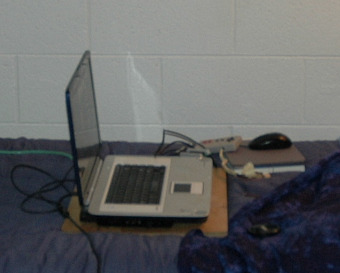

I either had it sitting on my desk next to my desktop computer (P4 or Phenom II x4), or used it sitting on my bed with a wooden board under it to give it sufficient ventilation so it wouldn't overheat or burn my legs. I disassembled that laptop several times over its lifetime, and replaced:
keyboards twice
the screen once (for the backlight)
4 hard drives
RAM once to upgrade from 1GB to 2GB
sound card subsystem once
battery twice
DVD drive once
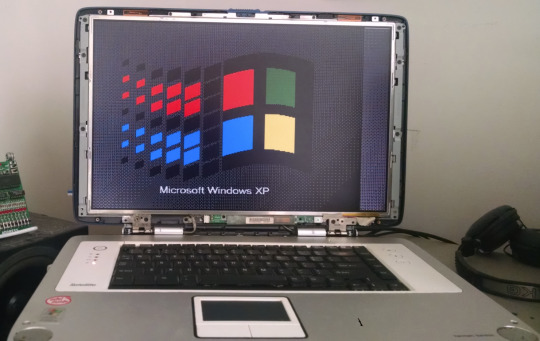
Eventually after it destroyed TWO IDE SSDs (yes, those are a thing you can buy) after a shorter than normal lifespan, I realized it was a losing battle and gave up the fight. I realized that it no longer served as a laptop, it couldn't keep pace with newer versions of Skype (before Discord was a thing), and sure as hell wasn't going to run Discord. It got slower and slower at running simple websites like my email, or youtube -- things that it used to handle just fine.
The form factor was limiting, and it was outmatched for the times, so I finally gave up and decided to retire it in favor of building a dedicated power-house XP desktop to do the jobs that it excelled at.
I bought a spare for parts to supplement it, so maybe one day I'll install a fresh hard drive (either spinning rust, or an IDE to m.2 adapter), and bring it back to a working state.
26 notes
·
View notes
Text
The ESP32 is a development board developed by Espressif systems. It can be programmed using Arduino IDE and ESP-IDF. It has higher processing power than ESP8266 but it is more costly and bigger in physical dimension than ESP8266. It has a built in Bluetooth module and CAN protocol and SRAM. It has 36 GPIO Pins with a CPU clock of 160MHz. It has 12-bit ADC onboard and supports CAN, UART, I2C and I2S. It can be used in prototyping IoT products, Low power Battery operated application, small range networking projects, and with the projects which require many Input Output Pins and Wi-Fi and Bluetooth connectivity.
6 notes
·
View notes
Text
I just had another thought about the possibility of CD-ROM support on the A3X.
If not as part of the BIOS, I could imagine a "driver" cartridge that, besides what the BIOS offers, adds ISO-9660 filesystem functions and handles finding, loading, and executing a program on the CD's data track. The cart itself has battery-backed SRAM for any CD-ROM based games to use, so it doubles as its own memory card.
Any program, be it the driver cart or otherwise, can detect the drive unit and use it to play CD-DA tracks or read raw 2 KiB data track sectors.
So path one: special cartridge offers CD-ROM filesystem support, handles loading games from CD, hosts SRAM. Path two: any other program can also see and control the drive unit (read raw sectors, play CD-DA), may have its own filesystem driver.
Does that make sense?
3 notes
·
View notes
Note
So, AIIIx, alias A3x, with felin mascots? I am just curious how much this could be used as a virtual storytelling device of sorts... But also because it is an emulator, pretty much.
For instance, can we have a global, long-term variable, e.g. a name, that is being kept in our A3x?
The A3X has no internal, persistent, shared storage available between cartridges or disk-borne programs like for example the internal memory of a CD-I player. What it does have is:
disk support, with plain FAT12 formatted diskettes and FAT16/32 hard drives, so when you think about it the only qualifier that has to be struck is "internal".
no care for disk-borne programs detecting certain cartridges and mucking around with any battery-backed SRAM that might be on those cartridges. ("You like Castlevania, don't you~")
4 notes
·
View notes
Text
https://www.futureelectronics.com/p/semiconductors--microcontrollers--8-bit/pic12f629t-i-sn-microchip-8748717
What is a microcontroller, programming microcontroller, lcd microcontrollers
PIC12F Series 1.75 kB Flash 64 B SRAM SMT 8-Bit Microcontroller - SOIC-8
#Microcontrollers#8 bit#PIC12F629T-I/SN#Microchip#what is a microcontroller#programming microcontroller#lcd#8 bit embedded microcontroller manufacturers#Low power microcontroller#usb#wireless#pic#Pic microcontroller#programming
1 note
·
View note